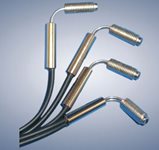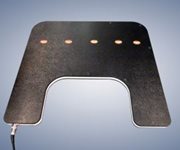Switches can give clients with physical limitations the ability to control almost anything including communication devices, iPads, power wheelchairs, environmental control devices, and more. While there are numerous types of switches on the market that vary in shape, size, function, color, activation method, and style; there are two main categories switches fall into: mechanical and electronic. Having an understanding of the categories of switches will help you select the best switch or combination of switches for each individual client.
For years Sunrise Medical customers have been able to utilize various switches to drive and/or operate specific functions on our wheelchairs. In April 2015 Switch-It, Inc. officially became a member of the Sunrise Medical family. To help explain the differences in mechanical and electronic switches, I reached out to Robert Norton, Director of Sales for Specialty Controls.
Overview of Switches & Power Wheelchairs
When it comes to a power wheelchair switches are commonly used for driving the chair, turning the wheelchair on and/or off, and controlling powered seating functions (i.e. tilt, recline, elevate, and leg rests). Switches have opened up the door to driving power wheelchairs for many clients who have, for whatever reason, not been able to utilize a standard joystick or alternative joystick.
Determining if switches are the appropriate option for a client is a multi-step process which includes identifying the most reliable switch site or sites (body parts and movements). The options for switch sites is practically limitless in terms of body parts and the amount of movement required. Once it has been established that a switch is going to be used, the type of switch then needs to be determined. There are several different switch options available on the market today that fall into the two primary categories, mechanical and electronic.
Mechanical Switches
A mechanical switch can be described as any switch in which the client must depress a button or other surface to cause a movement in the device thus activating the switch. Examples of mechanical switches appropriate to utilize for power mobility include:
Cinco Switch
(Available from Switch-It)

A mechanical switch may be appropriate for several reasons such as the client needs tactile feedback as reassurance that they have activated a switch. In addition a client may benefit from having switches in different colors to help with learning/recalling the function of each switch. This can be very helpful if a client would be successful in identifying red for forward, black for reverse, and yellow for mode or any combination of the available colors.
Electronic Switches
As opposed to mechanical switches which requires the user to make contact with the switch for activation, an electronic switch does not require pressure for activation. This can be especially helpful, when a client presents with limited movement and/or strength. Examples of electronic switches frequently utilized for power mobility include:
Proximity Switches
(Switch-It)

Fiber Optic Switches
(Switch-It)

Lap Tray with Switches
(Switch-It)

Electronic switches are often mounted inside mounting systems such as a head array or tray.
The switch is activated by "entering" the area of the switch signal. Switches such as proximity and fiber optic are always looking for something within its area so that it can activate. Thus little to no contact with the switch itself is required to engage the function. For example this can be extremely beneficial to a client with very limited hand movement as the switch can be mounted adjacent to their drive control and activated very easily to remain independent in accessing seat functions or any of the other desired functions discussed above.
Historically, one of the biggest downsides to driving with switches is the fact that switches are non-proportional, which means when the switch is activated the wheelchair is going at the top speed and the moment the switch is no longer engaged the wheelchair immediately stops. Proportional drive systems, such as joysticks, allow users to gradually increase or decrease speed by how far the joystick is deflected from neutral. Proportional systems are similar to the gas pedal on a car. Users report that smooth and efficient driving with a switch drive device such as a head array can be impossible.
Switch-It Dual Pro™
In an effort to improve functionality and provide users with better control when driving with a head array, Switch-It recently launched a fully proportional head array called the Dual Pro™. Similar to a traditional head array the Dual Pro utilizes proximity switches, but what makes the Dual Pro different is that it also has pressure switches embedded into the pads. By incorporating pressure switches the device can function as a proportional system.
The Dual Pro offers a number of on-board programming (no additional equipment such as programmer, dongle, PC, tablet, etc.) options that allow the device to be modified to each client's need. The proximity in which the user needs to be to the switch for it to activate and the amount of pressure required to bring the wheelchair to full speed can be programmed for each individual pad. Users have much more control when driving the wheelchair making precise movements with a head array possible.
Summary
When the use of a switch has been determined as the most appropriate access method for any function, placement of the switch is key. A client gaining freedom by use of a simple switch can be a very rewarding outcome. However, a misplaced or inappropriate switch can result in a very frustrating situation for any client. It is imperative that a consistent site is identified, one that the client can access whether it is first thing in the morning or at the end of the day when fatigue can be an issue. It is important to remember that when looking at switch placement, the opportunities are endless, when there is the cognitive ability to use a switch, there is a way to give the client freedom through switches.
- Robert Norton, ATP
Robert is currently the Director of Sales for Specialty Controls. He has been an ATP for 10 years and has over 20 years of experience in the complex rehabilitation technology industry. If you would like to reach out to Robert directly, please email him at robert.norton@sunmed.com.
Thank you for reading our blog! We love hearing from you, so please do not hesitate to reach out to us. We encourage you to leave a comment or send us an email at NAMarketing2@sunmed.com.
Always remember at the end of the day, your client is your number one priority!
- Angie
Follow Angie on Twitter @ATigerKiger